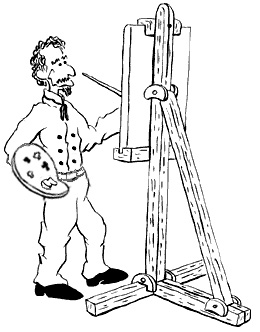
Tom Eakins
"Eakins Revealed: The Secret Life of an American Artist", Henry Adams, Oxford University Press, 2005, Uncorrected Readers Copy.
Mark Twain wrote that Wagner's music is better than it sounds, and the same might be true for this book. Or rather, "Eakins Revealed: The Secret Life of an American Artist" might be better than it reads. Maybe. But Kathleen Fosters' book "Writing About Eakins" covers most of the same topics, and with the forty-two fully printed verbatim letters, her book is better for the readers who prefer to decide for themselves what might have happened in Tom's hectic and controversial life.
It would be wrong to say that there are not some good things about this book, and when it sticks to the facts about Tom it can be very useful. The Eakins beginner will find a very nice chapter on the history of early Eakins scholarship, which traces how within a year of his death Tom went from being regarded as an out of work art teacher who sold virtually no paintings to be an honored artist with a major retrospective at the Metropolitan Museum in New York. By citing the notes of Tom's first biographer, Lloyd Goodrich, the book also points out that Lloyd heard a lot about Tom he didn't write about (other authors have, of course, looked at Lloyd's notes and found the same thing). But what isn't said is this might have been perfectly proper discretion since in interviews you can be peppered with hearsay, speculation, and innuendo (and Lloyd was). In works published while some of the individuals involved are still living, you have to be careful about what you print. Dead people can be neither libeled nor sue for libel; living people can do both. So titling that chapter "The Perfect Crime" seems far too pejorative.
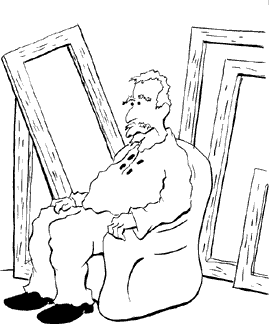
Tom Eakins - 1916.
Someone looking into the scandalous parts of Tom's life - his dismissal from the Pennsylvania Academy of the Fine Arts, the mental illness of his student Lillian Hammitt, and the suicide of his niece Ella Crowell - will find the episodes conveniently arranged each with their own chapters (but again, check out "Writing About Eakins" for added detail). In truth this book might have been a great book had it limited itself to presenting the known facts about these episodes and supplied more extensive supporting information. Fortunately the sections dealing with facts are at least somewhat separated from the pages of speculative (and quite invalid) psychoanalyzing of Eakins via his paintings that makes for such dreary and pointless reading.
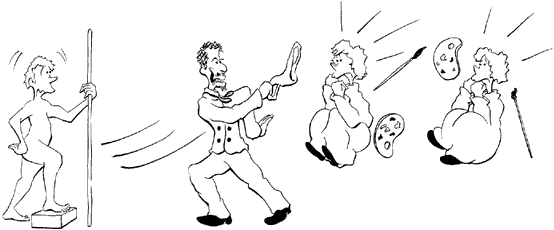
The incidents are arranged each in their own chapters.
As it is, the book could have been - and should have been - much better. Certainly, the book on the "secret life of Thomas Eakins" (whatever that means) still remains to be written. Among the many faults of the book is an almost immediate tendency to predispose the reader against Eakins with irrelevancies and prejudicial language. Before we get to the second chapter, we've learned that Tom's house smelled, that its walls hold deep dark secrets, that his dad was a slumlord, and that Tom "murdered" (that's the word used) his sister's cat. If that's not enough we're told that when a class of art history graduate students at Case Western Reserve University looked at a photo of Tom they thought he looked anything from conniving to a murderer. And we've still got over four hundred pages to go.
No one denies that much of Tom's behavior raises questions, both in regard to Victorian standards of propriety and our own. Tom's using the word "pee" to a young lady may not have been appropriate and an instructor asking an art student if she'd pose nude (or bare her back) would likely get into trouble today. And of course there's the famous incident where Tom invited a young lady to his studio to show her the working of the human pelvis in a way "that could not be illustrated by words alone". Although the lady seems to have gone along willingly, that remains - to say the least - an ill-advised way to illustrate a point of anatomy.
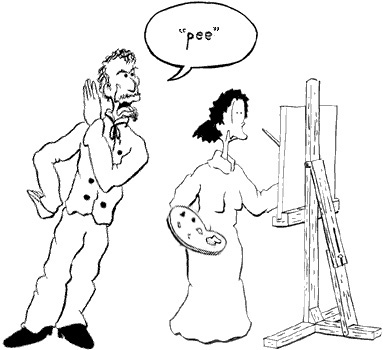
The word was probably not appropriate
But since questions about Tom's motives and behavior have been raised in years past, it's surprising that an underlying assumption behind the "Eakins Revealed" seems to be that the readers will have an idealistic picture of Eakins as painted (no pun intended) by Lloyd Goodrich's first biography. The text continues to stress how Tom is regarded as an idealistic, highly moral, paragon of truth, artistic justice, and the American Realist way. Twenty-odd years ago that may have been true; but even to the informed layman whose introduction to Tom is from the more recent works, it will be no revelation that the life of Tom Eakins was far from rosy red and many people, scholars and laymen alike, would like an explanation regarding some of Tom's actions. For instance William Innes Homer's book, "Thomas Eakins: His Life and Art" (available for over a decade) discusses in considerable depth some of Tom's more questionable behavior, and even the slim, easy reading (but informative) volume "The Essential Thomas Eakins" by Alice Carter covers many of the controversial points you read about in "Eakins Revealed".

An ill advised way to teach anatomy.
To be fair and as the book mentions, the difficulty any biographer of Tom encounters is that Tom cannot speak for himself. Eakins left very few letters. The most numerous correspondence are the letters he wrote as a young man while attending the Ecole des Beaux Artes in Paris. Once he got back to Philadelphia his letters are few and far between.
The lack of Tom's letters from his later years presents real problems since much of the information about Tom is second hand and speculation. Even people that knew Tom personally may be (and probably are) just recycling what they heard from someone else. So in the end we feel we're getting our information from a "friend of a friend" and wonder if what we're learning is any more reliable than the typical urban legend.
We are told, for instance, that "several informants" said Eakins forced his niece, Ella Crowell, to posed in the nude. Given that Ella later committed suicide with a shotgun and Ella's parents thought that improper behavior on Tom's part is what drove her to her death, we would really like to know who these "several" informants were and exactly what they said. But when we check out the reference, instead of "several informants" being cited, we're just pointed to a previously "unpublished interview" with Mrs. Weda Cook Addicks, who as a young woman posed for Tom's "The Concert Singer".
Well, who are these informants? How did Mrs. Addicks (who at the time of Ella's death was in her mid-twenties) learn of them? How did the informants get their information? We don't know and this skimpy reference of supporting information isn't unusual. Although there are some quotes of paragraph size, more are limited to short phrases or even single words. So we wonder if we were read the sources ourselves whether we reach the same conclusion as the author. Or any conclusions at all.
And what happens if you are able to dig for yourself? Well, some things we're told are simply flat out wrong. Take the case of Lillian's Hammitt, who was a student of Eakins. During the time Tom was painting her portrait she began to believe Tom was going to divorce his wife and marry her. When she wrote Tom about how their upcoming marriage, he was floored. Quite properly he broke off contact with her and wrote (but not too kindly) that he thought she was nuts (you'll have to go to Kathleen Foster's "Writing about Eakins" for the full text of the letter). Later Lillian went off the deep end entirely and began calling herself "Mrs. Eakins". Finally she was seen walking in downtown Philadelphia in a bathing suit and was taken to a mental institution where for all we know she remained the rest of her life.
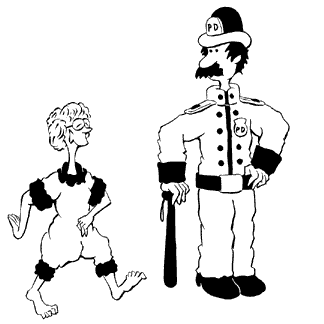
Lillian Hammitt
In the book's discussion of this episode, there is the implication that Tom's behavior - in general and possibly toward her - might have prodded her to a mental breakdown. After all, we are told, she wrote lucid letters before she went crazy and she went crazy after she met Tom. So that seems like a connection, right? Q. E. D.
The possibility that she spontaneously developed a disorder (such as schizophrenia) is discounted. After all, we learn, she was delusional, not paranoid, and did not exhibit the normal schizophrenic symptoms like hearing voices. And even more to the point, we are told, at 27 Lillian was too old for the normal onset of schizophrenia.
Now here's where the reasonably informed reader begins to scratch his head. First we have no idea whether Lillian had paranoid symptoms or not. Furthermore, a brief consultation of medical texts will reveal that 1) not all schizophrenics hear voices and 2) a major symptom of some forms of schizophrenia are in fact delusions. Can we discount schizophrenia or similar illness because her particular delusion of grandeur was rather low keyed (i. e., she was Mrs. Thomas Eakins) and wasn't the type usually cited for the layman; that is, because she didn't think she was Napoleon (or in her case Josephine)? We can, of course, argue this type of stuff endlessly.
But as far as the claim Lillian was too old for schizophrenia, this is totally, completely, and demonstrably false. Again if you dip into a medical reference on mental disorders you'll learn the disease most often develops in the early to mid-twenties for men and (pardon me for shouting) the LATE TWENTIES FOR WOMEN. More to the point, women have a wider range of onset - 26 to 45 - than men (18 to 25). So at 27, Lillian was right smack dab in the range for women.
So we are left with the uneasy suspicion that information is used selectively - and not always correctly - to make a lawyer's case against Eakins rather than used as a source for a historian's impartial evaluation. By the time you learn that Tom made his sitters stand or sit in uncomfortable poses and endure ten times as many sessions as a typical portrait painter, you wonder if this was typical.
Yes, we learn, as other writers have also said, Dr. Gross was asked to come back for so many sessions he wrote "Eakins, I wish you were dead!" And yes, Weda got tired of posing three or four time a week for "The Concert Singer". But Walt Whitman certainly didn't find sitting for Eakins all that onerous. Tom came by often, Walt said, but at intervals and - (direct quote) - "for short stretches". So then what percentage of Tom's sitters felt like Dr. Gross or Weda? Three-quarters? Half? A tenth? Only those cited in the book? Who knows? The truth is that extended poses for portraits is not that unusual and even the kindly and gentle John Singer Sargent once painted a portrait of a young girl over eighty-three sessions.
But without doubt the worst part of the book is the weary, straining, and spurious Freudian psychoanalyzing of Tom from his photographs or portraits. This goes on page after page using the most tenuous, not to say invalid, of reasoning.
If there is any field of modern medicine that can be honestly labeled as pseudoscience it has to be Freudian pyschology. As has been correctly pointed out (beginning even in Freud's time and continuing with downright vehemence in the last twenty years), Freud's theories are circular, untestable, and in modern scientific jargon, "unfalsifiable". Simply put this means Freudian theory can can be used to "prove" anything; true or false, Freudian analysis can prove it.
Naturally the consequences of using such theories for medical diagnoses can be disastrous and no one could illustrate this better than Freud himself. Once, he was called in to consult on a case where a young girl was complaining of stomach pains. Freud quickly diagnosed the girl's pains as "unmistakable hysteria". In a single day, he was able to cure her of her psychosomatic illness.
When the girl died two months later of stomach cancer, the good doctor admitted he had not properly diagnosed the girl's illness. But he hastily added, at least he had recognized - and cured - her stomach pains - which he said really were hysterical symptoms. And now he was able to tell what caused the "hysterical" symptoms in the first place. They were caused by the cancer!
And with this we're going to study the life of Thomas Eakins?

Patients could be assured their "hysterical" symptoms could be cured.
The truth is that Freudian and other psychoanalytic techniques have come under the increasing scrutiny of experimental psychologists and cognitive scientists. One particularly telling point is that so-called "projective" methods of analysis (which include Freudian analysis) can make perfectly normal people look mentally disturbed. Worse, there are disquieting similarities between the techniques used in Freudian psychoanalysis and those used in numerology (which Freud flirted with), astrology, and "psychic analysis" (i. e., fortune telling). And under controlled and properly designed scientific tests numerology, astrology, fortune telling - AND Freudian theory - fail miserably.
But we're told Freudian theory is just another "tool", for analyzing Tom and his paintings. So what's wrong with that? Well, would a historian try feeling "psychic vibrations" from a painting, casting the artist's horoscope, or by looking for numerological patterns in his subject's art and writings as a "tool"? I doubt that even in it's leaner years, Oxford University Press would publish a history book like that.
But we don't need to accept the absurdity of using Freudian analysis as a tool for historical research to wonder where in the world some of the conclusions of this book came from. For instance, we're told that in his photographs Tom looks "emotionally troubled" and even "mentally disturbed". That's right. He looks mentally disturbed. That's from his photographs.
This is where I begin to wonder if I'm actually understanding what I'm reading. Does the author actually believe you can diagnose a person's mental state or character by looking at his pictures? I thought physiognomy was thrown out with phrenology more than a hundred years ago? But here we are in twenty-first century, judging a man's character and psychology by the way he looks.
Without doubt the single most major - and fatal - flaw of this book is the author seems to believe that his personal interpretation of a painting or photograph is somehow related to an objective truth about the subject or artist. But if you let someone else play the game, it's easy to see that this isn't true. If you ask my opinion for instance, I'd say in his photos, Tom looks "serious". Or "thoughtful". Maybe even "intense". Still - believe it or not - I've seen photos where Tom Eakins was (gasp!) actually SMILING. And there is the famous photo of Tom, Samuel Murray, and another friend sitting at a table chatting. This picture is in the book and Tom looks quite relaxed and pleasant - especially for an emotionally troubled or mentally disturbed man.
Now let's return to the time the author passed out a photo of Eakins to his graduate students. If the tone of Eakins lectures at CWRU are anything like that of this book, we're not surprised to learn the students said Tom didn't look so good. He looked "conniving", said one. And another student even said he looked "like a murderer".
But rather than this telling us anything about Tom Eakins it just raises another question. Why in the world would a scholar perform such a meaningless exercise, much less publish it in a book by one of the world's most prestigious university presses? Once more we have to ask: Does the author really believe you can deduce a person's mental state or character by looking at his photographs?
Couldn't a professor at a major university - and at a university known for a strong science curriculum - do something that had at least SOME validity? Couldn't you objectively test whether Tom REALLY looks worse than other people? You could, for instance, randomly select a photo of Tom's and mix it with a ten other nineteenth century photographs. Do this for, say ten, photos of Tom. You then randomly select ten people who don't know who Tom Eakins was (and particularly people who don't know Tom killed his sister's cat). They then rank the photos from 1 to 10 the nicest looking subject to the meanest. You then average Tom's ranking.
Now the simplest of statistical analysis tells us that if the average of Tom's nastiness number falls between 3.7 and 7.3, we can say at the 95 % confidence level, Tom looks no worse or better than the average subject of nineteenth century photography. This experiment would at least have some validity and certainly there have to be cognitive scientists at CWRU could have designed and carried out even better tests.
But suppose the tests DID show Tom's photos made him look bad. That - and forgive me if we shout once more - STILL SAYS NOTHING ABOUT TOM'S CHARACTER. Let's repeat that once more, all together. YOU CAN'T BASE CHARACTER JUDGMENTS ON THE WAY A PERSON LOOKS. It was tried by law enforcement agencies in the nineteenth century and is meaningless, unscientific, and not worthy of a serious study. If there is research that shows you can do this - with proper sample size, controls, and statistical analysis - please send me the reference.
But without doubt the low point in the photographic interpretations in this book are the conclusions drawn from a photograph of Ella, Tom's niece, standing by a tree. To those who don't know the story, Ella committed suicide after (apparently) telling her parents that her Uncle Tom, among other things, subjected her to a "degradng touch" while she was staying with him and Susan.
Here's what we're told about this photo. Ella looks miserable. She is desperate. She not only did not want to be photographed, but she was being "hunted". Eakins (and believe it or not, this is really what the book says), had "trapped" Ella between himself and the tree. She was trying to "dodge to one side". Furthermore Eakins behavior was like a "lover's pursuit", we're told, but not a "playful" pursuit. Instead, Tom was pursuing her with a "hint of sadism".
I am absolutely flabbergasted. Am I to understand that a scholar in the twenty-first century really thinks that this type of information can be obtained from a blurry nineteenth century photograph?
I'll admit Ella isn't smiling and so you can't say she looks particularly happy. But just look through any book of nineteenth century photographs and see how many people are smiling. Not many. How many people don't look happy? Quite a few. The words "desperate" and "hunted" and the deductions about the "lover's pursuit" are absolute flights into fantasy.
It's not just that it's absolutely impossible for someone to deduce this type of balderdash from a more-than-a-century old photograph. A little thought, just a little, shows that the whole scenario is absolutely absurd.
Remember that Ella lived on a farm in Avondale, Pennsylvania with her mother, Frances, and her father, Will, (who we learn did nothing except sit around all day and read the newspapers). There were also nine - count 'em - nine siblings.. So are we to believe that as Ella's mom worked in the kitchen, her dad sat on the porch and read the papers, and her brothers and sisters worked or played in the yard, that Tom "hunted" Ella in a "lover's pursuit" with a "hint of sadism", "trapped" her by the tree (all this while carrying around a nineteenth century camera, mind you), and took her photo of her looking "desperate" before she "dodged away"?
The whole thing is even more absurd since it's likely at the same time and spot Tom also took a picture of Ella's dad looking nobly off into the distance ( click here for more on that). If that's true, then we have to suppose that after Tom chased Ella around and took her picture, he called over and said, "Well, Will, as you saw I just 'hunted' Ella in a 'lover's pursuit' with a 'hint of sadism' and 'trapped' her by this tree. Then I saw she looked 'desperate' and took her photo before she 'dodged away'. And since I've got my camera here I figured you might like your photograph, too. How about it?" And obviously Will said, "Why, Tom, that's fine with me. I'll put this newspaper down and stand looking nobly off into the distance. Maybe I can see where Ella 'dodged away' to."
For myself I'll simply conclude Tom took the Ella's photo (and possibly Will's) as family snapshots on a visit to Avondale. Maybe Ella didn't like her photo being taken, but the picture has nothing to say about the relationship between Ella and Tom.
Which brings us to the next step. Just as you can't judge a man by his photographs, NEITHER CAN YOU READ THE CHARACTER OR MENTAL STATE OF ARTISTS BY LOOKING AT THEIR PAINTINGS. And there is a LOT of that in this book, even a whole chapter, cheerfully titled "Conversations with the Dead". What a person a hundred or more years thinks the subject of a painting looks or feels like has nothing to do with what the artist or the subject actually DID think or felt like.
A point in case is the famous painting of Tom's wife, Susan, with their dog. Nowadays this picture is sometimes interpreted (and not just in this book) as reflecting Tom's negative attitude or perhaps indifference toward his wife. She looks "depressed", some say, or "anorexic". The dog, we are told, is painted with more tenderness than Susan.
Who knows? Maybe Eakins didn't really like Susan all that much, although that is certainly contrary to what he himself wrote. But if I'm allowed a little personal opinion here, I really think what we're seeing here is the "follow the leader" syndrome. Perhaps, just perhaps, people should look more at Tom's paintings and read less what the scholars say about them. Certainly when I first saw the picture in William Innes Homer's book I thought it was a pretty nice picture of Susan and their dog. My thought was she looked rather bemused.
Then when I read the text (AFTER I looked at the picture), I was surprised at the negative interpretation (and Homer is by no means anti-Eakins). Yes, Susan looks thin, maybe even thinner than she really was, but that's true for John Singer Sargent's surprisingly bad portrait of Robert Louis Stevenson (photographs show Stevenson was skinny, but not that skinny). Now if someone thinks Susan looks depressed in the painting, well, you're welcome to your opinion. I certainly didn't. But the point is what I, doctors, lawyers, artists, automobile mechanics, fortune tellers, graduate students, or college professors think about the painting has nothing to do with what Tom though or the way Susan felt.
But in "Eakins Revealed" we go even further in the negative interpretation of this picture. We are told that in an original version Susan looks better, younger, and less depressed. This is based on a photogravure of the earlier version and in the book it was printed along side the reproduction of the final painting.
Sorry, folks, but I just don't see it. Maybe again this means I, too, am mentally disturbed, but I think the final version makes Susan look much better. And personally I think she looks better in the painting than in her most of her photographs. (As an aside, it is a good picture of a dog, but as far as we know the painting has never been used by a qualified veterinarian to diagnose if the Eakins' dog had fleas.)
The book has literally pages of this type of interpretation of Tom's artwork. Virtually all of it has a distinctly negative tone against Tom and everything is based on the assumption that you can accurately assess the thoughts, mood, and psychology of the artists and sitters by looking at a painting.
It's pointless to go through each painting one by one just to say you don't think the subject looks as bad as you're supposed to. There is one painting, though, that is worth discussing further. That's the painting of Tom's sister Margaret in her skating costume.
In this painting Margaret is bundled up in a heavy coat wearing a fur cap with a red feather. Her look, we are told, is "blank", "uningratiating", "startling", ""frozen", almost rude". Maggie is "dressed like a man". She doesn't "engage the viewer". She looks "depressed", and the feather (we have to throw in a bit of Freudian allusion here, of course). "bleeds like a gash".
And what about Tom? Well, he painted a portrait that "breaks all rules of conventional portraiture". Not only that, but there is a "gender reversal" that would have been "shocking" to Tom's contemporaries. And Tom's painting of a woman with a frozen expression was "undoubtedly personal" for Tom. He is recording the "lethargy" of one with bipolar illness and from this we know the portrait was Tom's attempt to come to terms with his mother's mental illness.
But think that's all. Not in the least. We can learn even more about Tom. Because Maggie bore a strong resemblance to Tom, this is not just a picture of Maggie. It's a picture of Tom "as a woman". So it seems "reasonable" that Tom was using his sister as a "vehicle for getting into the mind of his mother" and for "even becoming his mother".
One of the main problems of the book is the author, akin with Freudian analysts, just can't accept a straightforward, unconvoluted answer. Maggie looks"blank" and "frozen"? So do her photographs. She looked like Tom? She was his sister, for crying out loud. The picture "breaks conventions". Wasn't that the point of realism? And if a nineteenth century woman dresses in a nineteenth century woman's skating costume, isn't she dressed like a woman?
And personally I don't think Maggie resembles Tom in the slightest.
But this portrait is useful for another reason. We can - with a little help from another picture - illustrate two points. First, that you can't tell what the artists are thinking by looking at their art. And secondly, that you can't you tell what the sitter was thinking, either. So in that case we can forget all that stuff about Tom's mother.
To do this let's keep with the spirit of Tom Eakins' era and let art borrow from science. That is, we'll just run a control. All we need to do is find a portrait where the thoughts of the artist AND the sitter are known and the expression on the subject looks like Maggie's. Then we'll do a little Freudian analysis and see how it compares with reality.
Impossible? Not really.
First, click here and look at the pictures. The portrait on the left is Tom's painting of Maggie. The other is a more contemporary portrait drawn by an artist of no particular merit (that is, yours truly). The point to remember is that the drawing was made with no thought whatsoever of imitating Eakins or any other artist.
It's hard to conjure up two portraits where the sitters have such similar expressions. And so we have to ask what a Freudian psychiatrist would say about the artist who did the drawing and the activity and emotional state of the subject.
At the very least, we suppose, the psychiatrist would knit his brows, and while stroking his beard, immediately diagnose the sitter as being "depressed". Shaking his head sadly, he would add that the artist who drew such a picture is very likely mentally disturbed. By choosing to draw a young man with long hair the artist is clearly in an emotionally confused condition and suffering from a cross-gender complex while at the same time no doubt striving to "become his mother". What is particularly troubling, he will point out, is the use of sanguine pastel. Since the word is derived from the Latin sanguis, "blood", the entire portrait is "bleeding like a gash", and we all know, he would nod sagely, what Freud would say about THAT. Worse, by doing the whole portrait in this color, the artist's clearly harbors hidden tendencies toward violence. Surely, then, a man rendering an adolescent's image in this medium has a suppressed hostility toward all young people. No doubt this would increase the depression of the sitter. The psychiatrist might suggest we call the police.
And the reality?
Well, all the artist himself remembers is just thinking what the heck he had to do to capture a good likeness. He was also pondering whether the picture would be good enough to take into his portrait class to show his instructor. The sanguine pencil was used because it was one of the techniques that had been introduced during the class, and the expression of the sitter was simply the most accurate that the artist could render.
And the subject? He was concentrating how he could defend the universe from the invading hordes of darkness. Yep. He was playing a video game.
Once more, folks, let's say it out loud. YOU CAN'T READ THE CHARACTER, THOUGHTS, OR PSYCHOLOGY OF ARTISTS OR THE SUBJECTS BY LOOKING AT THEIR PAINTINGS. Again, if there is any rigorous valid scientific study - with proper controls and statistically valid analysis - which shows that without prior knowledge, a subject's thoughts, character, and mental state (or in this case, past and present actions and motivation) can be determined from their photographs or artwork - once again please send me the reference.
This negative interpretation of Tom's photographs and paintings, by the way, is made easier because of the quality of the reproductions in this book. All are in black and white, and many are quite small. Now my own (and recent) on the spot examination of a number of Eakins' originals (including the picture of Maggie) have convinced me that - at least to a person as obviously mentally disturbed as I am - much of the somberness vanishes when the paintings are viewed at in full size and in color.
Of course, in a book that mentions that Tom's house smelled, we can't leave out saying he had a negative attitude toward women, can we? Again this is nothing new and is covered in earlier books about Tom. Objectionable as such comments may be to the contemporary reader (as are some of Thomas Jefferson's views on race), Tom's attitude was not at all unusual for men even up to (and often beyond) the mid-twentieth century. For instance, according to their official biographers, both J. R. R. Tolkien and Clarence Darrow (yes, super-liberal Clarence Darrow) did not believe women were equal to men, and both of these gentlemen made comments about women that were even more condescending than anything Tom ever said.
Perhaps in a book subtitled, "The Secret Life of an American Artist" we should expect to be regaled with negative episodes. But a secret life can work both ways. We learn nothing, for instance about Tom's relationships with or opinions of African Americans. Henry Tanner, a young African American artist of phenomenal talent and who later became extremely successful (once he moved to Europe), studied with Eakins. There is absolutely nothing about their relationship, nothing about Tom's own beautiful portrait of Henry, nor of Tom's sympathetic and unstereotyped representation of African Americans even in his earliest paintings. And if you want to try to deduce something from a person's painting, why not speculate about how one of Tom's finest paintings, "The Dancing Lesson" influenced Henry to produce an even greater American masterpiece, "The Banjo Lesson".
Finally after wearily winding your way through the book, the last chapter seems to hit a better balance regarding Thomas Eakins. Using coarse language to shock, parading around the house in your underwear (or less), and ostentatiously breaking wind is behavior, we are told, you often find in children. Could it be simply that Tom never quite grew up? There may be something to this and for other examples of famous artists and writers being a little (or not so little) self-ed and childish see the more recent biographies of Toulouse Lautrec, Ernest Hemingway, or the now more or less forgotten writer, James. T. Farrell.

Did Tom grow up?
But of course there's another, and more positive, explanation - although admittedly not an entirely comprehensive one. Maybe as with his painting, Tom was just ahead of his time. Co-educational figure drawing classes with totally nude male models? Routine today. Tom told ribald jokes? Not limited to masculine non-mixed company. And the "coarse" language? No big deal when you consider four letter words began appearing in Disney movies nearly a quarter of a century ago. Certainly Tom's joking remarks made during an animal drawing class when a cow (and pardon if this sounds "coarse") dropped a load would be greeted with laughter today.
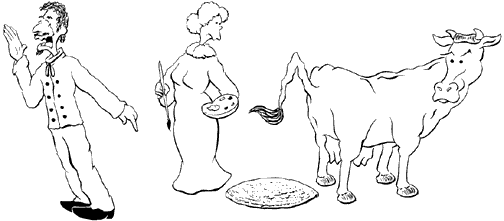
Tom's remarks would have been greeted with laughter today.
It's a pity that science and art are now much more widely separated than they were in Tom's time. Eakins Revealed: The Secret Life of an American Artist doesn't reveal much about Tom Eakins, but it does reveal that historians would be well advised to try a little - just a little - rigorous scientific reasoning themselves. It can be done and might result in books that are devoid of meaningless padding, stick to the facts, and are a pleasure to read.
Eakins Revealed: The Secret Life of an American Artist doesn't fit the bill. We really do expect better from a major academic study published by Oxford University Press.